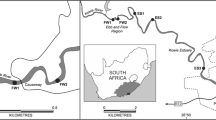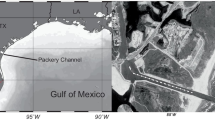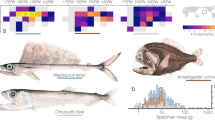Abstract
We describe overwintering habitats of age-0 American shad in the lower Chesapeake Bay estuary through analyses of multiple, complementary data sets, including bottom-trawls of the Virginia portion of Chesapeake Bay and its tributaries, stable isotope analysis of American shad and common prey items, and stomach content analysis. This is the first detailed description of overwintering habitats used by young American shad during their first migration to the Atlantic Ocean. American shad generally migrated from their freshwater rearing habitat during November and December and migrated to the ocean during February through March. American shad were captured in all of Virginia’s tributaries and along Chesapeake Bay’s western coast. These fish were caught in relatively cool waters (5–9°C) over a wide range of salinities (0.1–27.5). Strong selection for certain temperatures or salinities was not apparent. Stomach content and stable isotope analyses demonstrated that juveniles were feeding in the estuary, growing on a diet of estuarine calanoid copepods, mysid shrimps, and larval fishes. The stable isotope data were used to describe temperature- and size-cued migration from fresh water. Temperature was an important cue affecting both the timing and the rate of migration. Further, American shad exhibited at least three different size-related migration behaviors: most juveniles emigrated from the freshwater rearing habitat at 2–5 g (ca. 55–75 mm fork length); other juveniles emigrated at a size of 2 g or less and rapidly moved into the lower estuary; and finally, a few juveniles remained in the upper estuary and did not emigrate until they were 5 g or larger. A few American shad were captured with anomalous stable isotope signatures, which may be explained by migration into the Chesapeake Bay estuary from an adjacent system.








Similar content being viewed by others
References
Altabet MA (1988) Variations in nitrogen isotopic composition between sinking and suspended particles: implications for nitrogen cycling and particle transformation in the open ocean. Deep Sea-Res 35:535–554
Arthur SM, Manly BFJ, McDonald LL, Garner GW (1996) Assessing habitat selection when availability changes. Ecology 77:215–227
Chittenden ME (1969) Life history and ecology of the American shad, Alosa sapidissima, in the Delaware River. Dissertation, Rutgers University
Chittenden ME (1972) Responses of young American shad, Alosa sapidissima, to low temperatures. Trans Am Fish Soc 101:680–685
Cifuentes LA, Sharp JH, Fogel ML (1988) Stable carbon and nitrogen isotope biogeochemistry in the Delaware estuary. Limnol Oceanogr 33:1102–1115
Clift WM (1872) Shad culture. Trans Am Fish Soc 2:21–28
Davis JR, Cheek RP (1967) Distribution, food habits, and growth of young clupeids, Cape Fear River system, North Carolina. In: Webb JW (ed) Proceedings of the 20th annual conference of the Southeastern Association of Game and Fish Commissioners, Asheville, North Carolina, 1966
Deegan LA, Garritt RH (1997) Evidence for spatial variability in estuarine food webs. Mar Ecol Prog Ser 147:31–47
DeNiro MJ, Epstein S (1977) Mechanism of carbon isotope fractionation associated with lipid synthesis. Science 197:261–263
Dodson JJ, Legget WC (1973) Behavior of adult American shad (Alosa sapidissima) homing to the Connecticut River from Long Island Sound. J Fish Res Board Can 30:1847–1860
Feuchtmayr H, Grey J (2003) Effect of preparation and preservation procedures on carbon and nitrogen stable isotope determinations from zooplankton. Rap Comm Mass Spec 17:2605–2610
Friedland KD, Hansen LP, Dunkley DA, MacLean JC (2000) Linkage between ocean climate, post-smolt growth, and survival of Atlantic salmon (Salmo salar L.) in the North Sea area. ICES J Mar Sci 57:419–429
Fry B, Arnold C (1982) Rapid 13C/12C turnover during growth of brown shrimp (Penaeus aztecus). Oecologia 54:200–204
Godwin WG, Adams JG (1969) Young clupeids of the Altamaha River, Georgia. Georgia Game and Fish Commission, Marine Fisheries Division, Contribution Series No. 15
Hammann MG (1981) Utilization of the Columbia River estuary by American shad, Alosa sapidissima (Wilson). Estuaries 4:287
Herzka SZ, Holt GJ (2000) Changes in isotopic composition of red drum (Sciaenops ocellatus) larvae in response to dietary shifts: potential applications to settlement studies. Can J Fish Aquat Sci 57:137–147
Hesslein RH, Hallard KA, Ramlal P (1993) Replacement of sulfur, carbon, and nitrogen in tissue of growing broad whitefish (Coregonus nasus) in response to a change in diet traced by δ34S, δ13C, and δ15N. Can J Fish Aquat Sci 50:2071–2076
Hildebrand SF, Schroeder WC (1927) Fishes of Chesapeake Bay. Bull US Bur Fish 43:92–100
Hobson KA (1999) Tracing origins and migration of wildlife using stable isotopes: a review. Oecologia 120:314–236
Hoffman JC (2006) Natal-river to estuary migration of American shad: estimating the value of essential rearing habitat. Dissertation, The College of William and Mary
Hoffman JC, Bronk DA (2006) Inter-annual variation in stable carbon and nitrogen isotope biogeochemistry of the Mattaponi River, Virginia. Limnol Oceanogr 51:2319–2332
Hoffman JC, Olney JE (2005) Cohort-specific growth and mortality of juvenile American shad in the Pamunkey River, Virginia. Trans Am Fish Soc 134:1–18
Leggett WC (1976) The American shad (Alosa sapidissima), with special reference to its migration and population dynamics in the Connecticut River. In: Merriman D, Thorpe LM (eds) The Connecticut River ecological study. Monograph 1. American Fisheries Society, Washington DC, pp 69–225
Leggett WC, Whitney RR (1972) Water temperature and migrations of American shad. Fish Bull 70:659–670
Limburg KE (1995) Otolith strontium traces migratory histories of juvenile American shad, Alosa sapidissima. Mar Ecol Prog Ser 119:25–35
Limburg KE (1996) Growth and migration of 0-year American shad (Alosa sapidissima) in the Hudson River estuary: otolith microstructural analysis. Can J Fish Aquat Sci 53:220–238
Limburg KE (1998) Anomalous migration of anadromous herrings revealed with natural chemical tracers. Can J Fish Aquat Sci 55:431–437
Limburg KE (2001) Through the gauntlet again: demographic restructuring of American shad by migration. Ecology 82:1584–1596
Limburg KE, Hattala KA, Kahnle A (2003) American shad in its native range. Am Fish Soc Symp 35:125–140
MacAvoy SE, Macko SA, Garman GC (1998) Tracing marine biomass into tidal freshwater ecosystems using stable sulfur isotopes. Naturwissenschaften 85:544–546
Maki KL, Hoenig JM, Olney JE (2001) Estimating proportion mature when immature fish are unavailable for study, with application to American shad (Alosa sapidissima) in the York River, Virginia. J N Am Fish Mgmt 21:703–716
Marcy BC (1976) Early life histories of American shad in the lower Connecticut River and the effects of the Connecticut Yankee plant. In: Merriman D, Thorpe LM (eds) The Connecticut River ecological study. Monograph 1. American Fisheries Society, Washington DC, pp 141–168
Mariotti A, Germon JC, Hubert P, Kaiser P, Letolle R, Tardieux A, Tardieux P (1981) Experimental determination of nitrogen kinetic isotope fractionation: Some principles; illustration for the denitrification and nitrification processes. Plant Soil Sci 62:413–430
McConnaughey T, McRoy CP (1979) Food-web structure and the fractionation of carbon isotopes in the Bering Sea. Mar Biol 53:257–262
Michener RH, Schell DM (1994) Stable isotope ratios as tracers in marine and aquatic food webs. In: Lajhta K, Michener RH (eds) Stable isotopes in ecology and environmental science. Blackwell Scientific Publications, Oxford
Milstein CB (1981) Abundance and distribution of juvenile Alosa species off southern New Jersey. Trans Am Fish Soc 110:306–309
Miyake Y, Wada E (1971) The isotope effect on the nitrogen in biochemical, oxidation–reduction reactions. Rec Oceanogr Works Jpn 11:1–6
Mook WG, Tan FC (1991) Stable carbon isotopes in rivers and estuaries. In: Degens ET, Kempe S, Richey JE (eds) Biogeochemistry of major world rivers. Wiley & Sons, New York
Murdy EO, Birdsong RS, Musick JA (1997) Fishes of Chesapeake Bay. Smithsonian Institution Press, Washington DC
Neves RJ, Depres L (1979) The oceanic migration of American shad, Alosa sapidissima, along the Atlantic coast. Fish Bull 77:199–212
O’Leary JA, Kynard B (1986) Behavior, length, and sex ratio of seaward-migrating juvenile American shad and blueback herring in the Connecticut River. Trans Am Fish Soc 115:529–536
Olney JE, Hoenig JM (2001) Managing a fishery under moratorium: assessment opportunities for Virginia’s stocks of American shad. Fisheries 26:6–12
Olney JE, Hopler DA, Gunter TP, Maki KL, Hoenig JM (2003) Signs of recovery of American shad in the James River, Virginia. Am Fish Soc Symp 35:323–329
Post DM (2002) Using stable isotopes to estimate trophic position: models, methods, and assumptions. Ecology 83:703–718
Raymond PA, Bauer JE (2001) DOC cycling in a temperature estuary: a mass balance approach using natural 14C and 13C isotopes. Limnol Oceanogr 46:655–667
Rikardsen AH, Haugland M, Bjørn PA, Finstad B, Knudsen R, Dempson JB, Holst JC, Hvidsten NA, Holm M (2004) Geographic differences in marine feeding of Atlantic salmon post-smolts in Norwegian fjords. J Fish Biol 64:1655–1679
Secor DH, Henderson-Arzapalo A, Piccoli PM (1995) Can otolith microchemistry chart patterns of migration and habitat utilization in anadromous fishes? J Exp Mar Biol Ecol 192:15–33
Stokesbury KDE, Dadswell MJ (1989) Seaward migration of juveniles of three herring species, Alosa, from an estuary in the Annapolis River, Nova Scotia. Can Field-Nat 103:388–393
Sweeting CJ, Polunin NVC, Jennings S (2006) Effects of chemical lipid extraction and arithmetic lipid correction on stable isotope ratios of fish tissues. Rap Commun Mass Spectrom 20:595–601
Thorrold SR, Jones CM, Campana SE, McLaren JW, Lam JWH (1998) Trace element signatures in otoliths record natal river of juvenile American shad (Alosa sapidissima). Limnol Oceanogr 43:1826–1835
Vander Zanden MJ, Rasmussen JB (2001) Variation in δ15N and δ13C trophic fractionation: implications for aquatic food web studies. Limnol Oceanogr 46:2061–2066
Wada E, Hattori A (1978) Nitrogen isotope effects in the assimilation of inorganic nitrogenous compounds. Geomicrobiol J 1:85–101
Walburg CH (1960) Abundance and life history of shad, St. John Rivers, Florida. Fish Bull 60:487–501
Wilhite ML, Maki KL, Hoenig JM, Olney JE (2003) Toward validation of a juvenile index of abundance for American shad in the York River, Virginia. Am Fish Soc Symp 35:285–294
Williams RO, Bruger GE (1972) Investigations on American shad in the St. Johns River. Technical Series No. 66. Marine Research Laboratory, State of Florida Department of Natural Resources, St. Petersburg, Florida
Zydlewski J, McCormick SD, Kunkel JG (2003) Late migration and seawater entry is physiologically disadvantageous for American shad juveniles. J Fish Biol 63:1521–1537
Acknowledgements
We thank H. Brooks, W. Lowery, and the staff of the VIMS Juvenile Finfish and Blue Crab Trawl Survey for field collections, K. Delano for preparing samples, and D. Harris for stable isotope analysis. J.C.H. was supported by a National Science Foundation Graduate Research Fellowship. The project was sponsored in part by NOAA Office of Sea Grant, U.S. Department of Commerce, under Grant NA03OAR4170084 to the Virginia Graduate Marine Science Consortium and Virginia Sea Grant College Program, and by the Wallop-Breaux Program of the U.S. Fish and Wildlife Service through the Marine Recreational Fishing Advisory Board of the Virginia Marine Resources Commission (Grant numbers F-116-R-6 and F-116-R-7). This is contribution 2802 of the Virginia Institute of Marine Science, The College of William and Mary.
Author information
Authors and Affiliations
Corresponding author
Rights and permissions
About this article
Cite this article
Hoffman, J.C., Limburg, K.E., Bronk, D.A. et al. Overwintering habitats of migratory juvenile American shad in Chesapeake Bay. Environ Biol Fish 81, 329–345 (2008). https://doi.org/10.1007/s10641-007-9204-y
Received:
Accepted:
Published:
Issue Date:
DOI: https://doi.org/10.1007/s10641-007-9204-y




